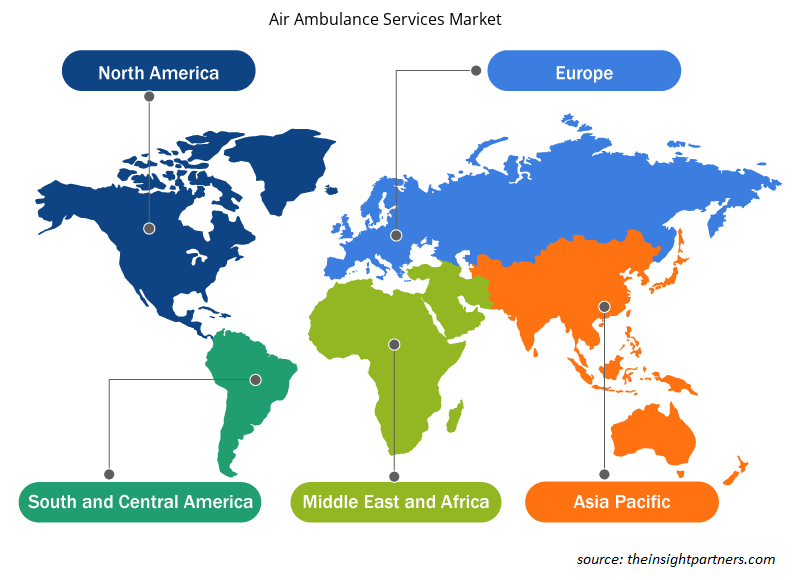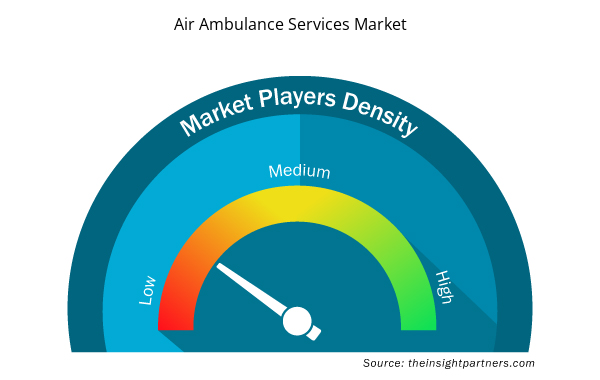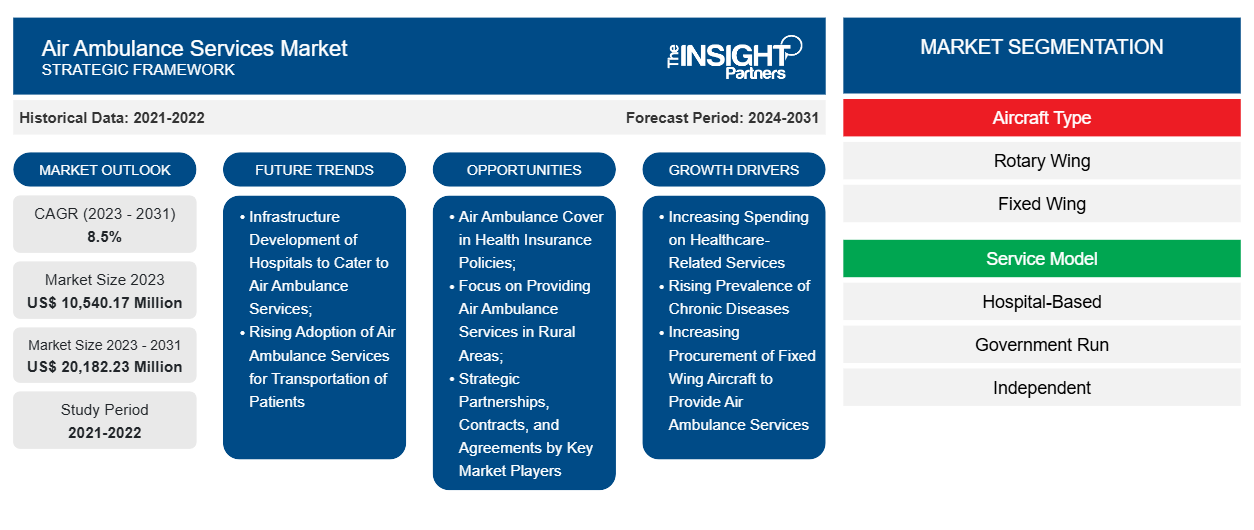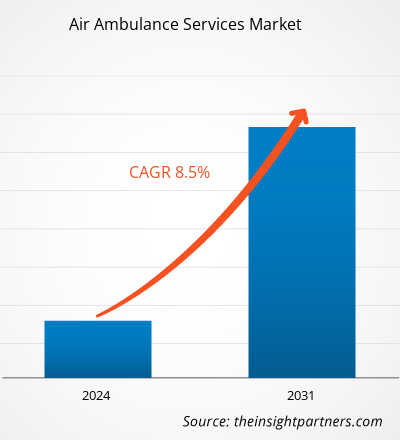空中救护服务市场规模预计将从 2023 年的 105.4017 亿美元增至 2031 年的 201.8223 亿美元。预计 2023-2031 年期间该市场的复合年增长率为 8.5%。医疗相关服务支出的增加可能仍是空中救护服务市场的主要趋势之一。
空中救护服务市场分析
空中救护服务市场相当分散,不同地区有大量参与者。空中救护服务的需求主要来自紧急医疗情况下的更高需求,即需要将患者转移到另一个合适的地点接受治疗。不同地区的各种当局一直在采取措施,在各自的地区建立空中救护基础设施。不同国家的几个州政府也在大力投资建设新的直升机停机坪或跑道,以更好地满足紧急医疗需求。例如,2023 年 7 月,印度马哈拉施特拉邦政府宣布计划在孟买-纳格浦尔 Samruddhi 高速公路上专门为空中救护车建立 16 个新的直升机停机坪。
空中救护服务市场概况
将患者从一个地方运送到另一个地方需要患者、医疗机构和运输服务提供商之间的大量护理和协调。运输方式取决于患者的医疗状况和医院位置。所需医疗设备、距离、患者流动性和处理成本等因素。运输团队、医疗保健和患者之间需要适当的沟通和规划,才能安全转移。私募股权公司控制着全球固定翼和直升机空中救护车市场的三分之二左右。空中救护车服务因多种用途而广受欢迎,包括将患者转移到医院、医疗旅游、国际患者护理和器官移植。空中救护车确保移植器官的安全运输,并提高器官移植手术的成功率。全球有多家公司正在采用这些空中救护车服务。例如,2024 年 1 月,ICATT 印度班加罗尔基地拥有 15 架固定翼飞机和 2 架直升机,用于国际和国内转移。该公司在印度每天提供 1-2 次国内患者转移和每周 3 次国际旅行。越来越多的医院开始采用空中救护服务进行病人护理以及将病人从一家医院转移到另一家医院,这导致了对空中救护服务的巨大需求。
定制此报告以满足您的需求
您可以免费定制任何报告,包括本报告的部分内容、国家级分析、Excel 数据包,以及为初创企业和大学提供优惠和折扣
- 获取此报告的关键市场趋势。这个免费样品将包括数据分析,从市场趋势到估计和预测。
空中救护服务市场驱动因素和机遇
增加固定翼飞机采购以提供空中救护服务
固定翼飞机用于远距离运送病人。政府提供空中救护服务的举措和计划的增加是市场的主要驱动因素。例如,2024 年 3 月,马尔代夫总统在该国启动了空中救护服务。马尔代夫卫生部发布了一份关于在马尔代夫开始运营空中救护服务的文件。2023 年 11 月,安大略省政府为 Ornge 的空中救护服务增加了四架固定翼 Pilatus PC-12 飞机。固定翼飞机总订单达到 12 架,价值超过 1.08 亿美元。空中救护服务包括病人转移、新生儿转移、儿科紧急运输服务、减肥病人手术、体外氧合手术、主动脉内球囊泵手术和水上航空医疗运输。因此,增加采购固定翼飞机以提供空中救护服务推动了市场增长。
专注于为农村地区提供空中救护服务
农村医院面临着许多问题,包括医生短缺、医疗器械缺乏以及缺乏紧急医疗服务。因此,各公司正在采取措施,为全球农村社区提供空中救护服务。例如,总部位于美国科罗拉多州的空中救护服务提供商 Air Methods 花费了大量资金将患者从农村医院转移出去。此外,政府对农村地区空中救护服务的举措和资金也有所增加。例如,2023 年 6 月,美国政府当局推出了《无支持立法法案》,以改善美国农村社区获得紧急空中医疗服务的机会。这项《美国人法案》使用《无意外法案》收集的数据,为美国各地农村社区提供紧急空中服务的报销率。空中救护车提供救生服务,尤其是对堪萨斯州的许多农村地区。全球农村地区越来越重视提供空中救护服务,预计将为空中救护服务市场增长创造充足的机会。
空中救护服务市场报告细分分析
有助于得出空中救护服务市场分析的关键部分是飞机类型、服务模式和最终用户。
- 根据飞机类型,空中救护服务市场分为旋翼机和固定翼机。旋翼机在 2023 年占据了较大的市场份额。
- 根据服务模式,市场分为医院型、政府运营型和独立型。2023 年,医院型市场占据了最大的市场份额。
- 从终端用户来看,市场分为国内和国际两部分。2023 年,国内市场占据主导地位。
空中救护服务市场份额(按地区)分析
空中救护服务市场报告的地理范围主要分为五个地区:北美、亚太、欧洲、中东和非洲、南美/南美和中美。
北美在空中救护服务市场占据主导地位。新建多专科医院和护理中心等医疗基础设施的不断增长,以及对紧急医疗救助服务等医疗设施的日益关注,预计将推动北美空中救护服务市场的增长。心血管疾病、癌症和中风等慢性病的发病率不断上升,消费者越来越倾向于使用紧急医疗服务来获得更好的即时医疗服务,这些都是导致北美空中救护服务市场占据主导地位的因素。预计亚太地区将在未来几年实现最高的复合年增长率。
空中救护服务市场新闻和最新发展
空中救护服务市场通过收集一手和二手研究后的定性和定量数据进行评估,其中包括重要的公司出版物、协会数据和数据库。以下是空中救护服务市场的发展情况:
- TrustAir Aviation 和两家匈牙利公司 ARworks 联合开发了一款独特而创新的 VR 培训应用程序,用于模拟航空医疗运输的具体情况。这款突破性的应用程序允许在医疗保健环境中使用和利用 VR 技术以及人工智能带来的好处,这是以前从未利用过的。
- FAI rent-a-jet GmbH 的空中救护部门宣布,其迪拜医疗护送服务已获得欧洲航空医学研究所 (EURAMI) 颁发的商业航空医疗护送 (CAME) 认证。此前,FAI 已于 2023 年初获得 EURAMI 认证,成为经批准的提供商。CAME 认证认可执行患者转移的航空医疗提供商,如 FAI,可以运送坐在机舱内或指定担架上的患者。FAI 是海湾合作委员会 (GCC) 中第一家获得 EURAMI CAME 认证的私营公司,也是唯一一家在海湾合作委员会中同时获得 CAME 认证和 EURAMI 批准提供商认证的欧洲固定翼飞机运营商。
空中救护服务市场区域洞察
Insight Partners 的分析师已详尽解释了预测期内影响空中救护服务市场的区域趋势和因素。本节还讨论了北美、欧洲、亚太地区、中东和非洲以及南美和中美洲的空中救护服务市场细分和地理位置。

- 获取空中救护服务市场的区域特定数据
空中救护服务市场报告范围
| 报告属性 | 细节 |
|---|---|
| 2023 年的市场规模 | 105.4017亿美元 |
| 2031 年市场规模 | 201.8223亿美元 |
| 全球复合年增长率(2023 - 2031) | 8.5% |
| 史料 | 2021-2022 |
| 预测期 | 2024-2031 |
| 涵盖的领域 | 按飞机类型
|
| 覆盖地区和国家 | 北美
|
| 市场领导者和主要公司简介 |
|
空中救护服务市场参与者密度:了解其对业务动态的影响
空中救护服务市场正在快速增长,这得益于最终用户需求的不断增长,这些需求源于消费者偏好的不断变化、技术进步以及对产品优势的认识不断提高等因素。随着需求的增加,企业正在扩大其产品范围,进行创新以满足消费者需求,并利用新兴趋势,从而进一步推动市场增长。
市场参与者密度是指在特定市场或行业内运营的企业或公司的分布情况。它表明相对于给定市场空间的规模或总市场价值,有多少竞争对手(市场参与者)存在于该市场空间中。
在空中救护服务市场运营的主要公司有:
- 空气方法
- 航空卫生有限公司
- 艾尔莱克航空
- 巴布科克国际集团
- 信托航空有限公司
- FAI航空集团
免责声明:上面列出的公司没有按照任何特定顺序排列。

- 获取空中救护服务市场顶级关键参与者概览
空中救护服务市场报告范围和交付成果
“空中救护服务市场规模和预测(2023-2031)”报告对以下领域进行了详细的市场分析:
- 范围内所有主要细分市场的全球、区域和国家层面的市场规模和预测
- 市场动态,如驱动因素、限制因素和关键机遇
- 未来主要趋势
- 详细的 PEST/波特五力分析和 SWOT 分析
- 全球和区域市场分析涵盖关键市场趋势、主要参与者、法规和最新市场发展
- 行业格局和竞争分析,涵盖市场集中度、热点图分析、知名参与者和最新发展
- 详细的公司简介
- 历史分析(2 年)、基准年、预测(7 年)及复合年增长率
- PEST 和 SWOT 分析
- 市场规模价值/数量 - 全球、区域、国家
- 行业和竞争格局
- Excel 数据集


- Online Exam Proctoring Market
- GNSS Chip Market
- Skin Graft Market
- Joint Pain Injection Market
- Aesthetic Medical Devices Market
- Clear Aligners Market
- Visualization and 3D Rendering Software Market
- Underwater Connector Market
- Semiconductor Metrology and Inspection Market
- Water Pipeline Leak Detection System Market

Report Coverage
Revenue forecast, Company Analysis, Industry landscape, Growth factors, and Trends

Segment Covered
This text is related
to segments covered.

Regional Scope
North America, Europe, Asia Pacific, Middle East & Africa, South & Central America

Country Scope
This text is related
to country scope.
常见问题
Increasing spending on healthcare-related services and the rising prevalence of chronic diseases are acting as major driver for air ambulance services.
Air Methods, Aero-Dienst GmbH, Airlec Air Espace, Babcock International Group Plc, Trust Air Aviation Ltd, FAI Aviation Group, IAS Medical, Medical Air Service, PHI Air Medical, and Quick Air Jet Charter GmbH are the key market players operating in the global air ambulance services market.
North America is one of the major regions in the air ambulance services market owing to mounting prevalence of chronic diseases.
Growing investment in healthcare industry and increasing prevalence of chronic diseases are acting as major drivers for the air ambulance services market.
Patient transport from one place to another requires significant care and coordination between patients, healthcare facilities, and transport service providers. The mode of transportation depends on the patient's medical condition and hospital location. Factors such as required medical equipment, distance, patient mobility, and cost of addressing. With proper communication and planning between transport teams, healthcare, and patients to be moved safely. Private equity companies control around two-thirds of both the fixed-wing and helicopter air ambulance markets worldwide. Air ambulance services have gained popularity for several purposes, including patient transfer to hospitals, medical tourism, international patient care, and organ transplantation. Air ambulances ensure safe transportation of the organs for transplantation and enhance the success rates of organ transplantation surgeries. Several companies are adopting these air ambulance services across the world.
Trends and growth analysis reports related to Aerospace and Defense : READ MORE..
The List of Companies - Air Ambulance Services Market
- Air Methods
- Aero-Dienst GmbH
- Airlec Air Espace
- Babcock International Group Plc
- Trust Air Aviation Ltd
- FAI Aviation Group
- IAS Medical
- Medical Air Service
- PHI Air Medical
- Quick Air Jet Charter GmbH
The Insight Partners performs research in 4 major stages: Data Collection & Secondary Research, Primary Research, Data Analysis and Data Triangulation & Final Review.
- Data Collection and Secondary Research:
As a market research and consulting firm operating from a decade, we have published and advised several client across the globe. First step for any study will start with an assessment of currently available data and insights from existing reports. Further, historical and current market information is collected from Investor Presentations, Annual Reports, SEC Filings, etc., and other information related to company’s performance and market positioning are gathered from Paid Databases (Factiva, Hoovers, and Reuters) and various other publications available in public domain.
Several associations trade associates, technical forums, institutes, societies and organization are accessed to gain technical as well as market related insights through their publications such as research papers, blogs and press releases related to the studies are referred to get cues about the market. Further, white papers, journals, magazines, and other news articles published in last 3 years are scrutinized and analyzed to understand the current market trends.
- Primary Research:
The primarily interview analysis comprise of data obtained from industry participants interview and answers to survey questions gathered by in-house primary team.
For primary research, interviews are conducted with industry experts/CEOs/Marketing Managers/VPs/Subject Matter Experts from both demand and supply side to get a 360-degree view of the market. The primary team conducts several interviews based on the complexity of the markets to understand the various market trends and dynamics which makes research more credible and precise.
A typical research interview fulfils the following functions:
- Provides first-hand information on the market size, market trends, growth trends, competitive landscape, and outlook
- Validates and strengthens in-house secondary research findings
- Develops the analysis team’s expertise and market understanding
Primary research involves email interactions and telephone interviews for each market, category, segment, and sub-segment across geographies. The participants who typically take part in such a process include, but are not limited to:
- Industry participants: VPs, business development managers, market intelligence managers and national sales managers
- Outside experts: Valuation experts, research analysts and key opinion leaders specializing in the electronics and semiconductor industry.
Below is the breakup of our primary respondents by company, designation, and region:

Once we receive the confirmation from primary research sources or primary respondents, we finalize the base year market estimation and forecast the data as per the macroeconomic and microeconomic factors assessed during data collection.
- Data Analysis:
Once data is validated through both secondary as well as primary respondents, we finalize the market estimations by hypothesis formulation and factor analysis at regional and country level.
- Macro-Economic Factor Analysis:
We analyse macroeconomic indicators such the gross domestic product (GDP), increase in the demand for goods and services across industries, technological advancement, regional economic growth, governmental policies, the influence of COVID-19, PEST analysis, and other aspects. This analysis aids in setting benchmarks for various nations/regions and approximating market splits. Additionally, the general trend of the aforementioned components aid in determining the market's development possibilities.
- Country Level Data:
Various factors that are especially aligned to the country are taken into account to determine the market size for a certain area and country, including the presence of vendors, such as headquarters and offices, the country's GDP, demand patterns, and industry growth. To comprehend the market dynamics for the nation, a number of growth variables, inhibitors, application areas, and current market trends are researched. The aforementioned elements aid in determining the country's overall market's growth potential.
- Company Profile:
The “Table of Contents” is formulated by listing and analyzing more than 25 - 30 companies operating in the market ecosystem across geographies. However, we profile only 10 companies as a standard practice in our syndicate reports. These 10 companies comprise leading, emerging, and regional players. Nonetheless, our analysis is not restricted to the 10 listed companies, we also analyze other companies present in the market to develop a holistic view and understand the prevailing trends. The “Company Profiles” section in the report covers key facts, business description, products & services, financial information, SWOT analysis, and key developments. The financial information presented is extracted from the annual reports and official documents of the publicly listed companies. Upon collecting the information for the sections of respective companies, we verify them via various primary sources and then compile the data in respective company profiles. The company level information helps us in deriving the base number as well as in forecasting the market size.
- Developing Base Number:
Aggregation of sales statistics (2020-2022) and macro-economic factor, and other secondary and primary research insights are utilized to arrive at base number and related market shares for 2022. The data gaps are identified in this step and relevant market data is analyzed, collected from paid primary interviews or databases. On finalizing the base year market size, forecasts are developed on the basis of macro-economic, industry and market growth factors and company level analysis.
- Data Triangulation and Final Review:
The market findings and base year market size calculations are validated from supply as well as demand side. Demand side validations are based on macro-economic factor analysis and benchmarks for respective regions and countries. In case of supply side validations, revenues of major companies are estimated (in case not available) based on industry benchmark, approximate number of employees, product portfolio, and primary interviews revenues are gathered. Further revenue from target product/service segment is assessed to avoid overshooting of market statistics. In case of heavy deviations between supply and demand side values, all thes steps are repeated to achieve synchronization.
We follow an iterative model, wherein we share our research findings with Subject Matter Experts (SME’s) and Key Opinion Leaders (KOLs) until consensus view of the market is not formulated – this model negates any drastic deviation in the opinions of experts. Only validated and universally acceptable research findings are quoted in our reports.
We have important check points that we use to validate our research findings – which we call – data triangulation, where we validate the information, we generate from secondary sources with primary interviews and then we re-validate with our internal data bases and Subject matter experts. This comprehensive model enables us to deliver high quality, reliable data in shortest possible time.


 获取此报告的免费样本
获取此报告的免费样本